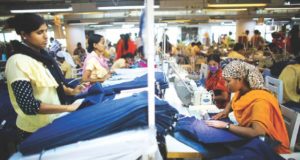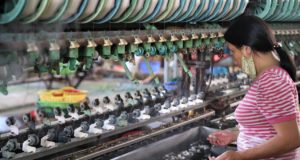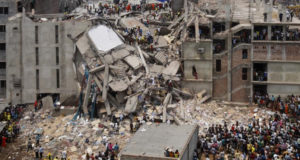By Robin Spiess
Published in The Phnom Penh Post on April 05, 2018

Photo: Vireak Mai/ The Phnom Penh Post
Cambodia’s garment sector is the backbone of the country’s export-driven economy and employs 86 percent of all factory workers. But the sector faces threats from increasingly competitive regional neighbours, the inevitable shift to automation and the potential loss of preferential trade agreements.
The stakes couldn’t be higher for the country’s economy. About 40 percent of Cambodia’s GDP comes from garment exports, while more than 800,000 people are employed in garment factories around the country.
But as Cambodia’s political situation has deteriorated with the dissolution of the main opposition party in November, and as the push to lower electricity and logistics costs for businesses have taken a backseat to populist policy initiatives, the garment sector is facing several risks that threaten the industry’s short- and long-term future in the Kingdom.
Competitiveness
Cambodia remains competitive in the global garments marketplace primarily because of its low wages, according to analysts. But recent years have seen steep wage hikes for garment factory workers, and that trend has accelerated ahead of July’s national elections.
The minimum wage has risen from $61 in 2012 to $170 this year. And as Prime Minister Hun Sen has attempted to woo garment workers ahead of the election, more populist policies have been enacted, including an increased burden for businesses to pay into their workers’ funds at the National Social Security Fund.
In a recent speech, the prime minister said that experts had floated $250 per month as a reasonable minimum wage by 2023, and said he thought it could go even higher. That could be disastrous, according to some factory owners that operate in Cambodia.
“We cannot survive a 12 percent wage increase every year,” said Eric Tavernier, CEO of France-based textile firm We Group Ltd. While Tavernier said he has no immediate plans to leave the country, the increased financial burden of doing business in the Kingdom worried him.
“I believe a significant number of factories feel the pressure to consider moving out, and not many are willing to come in,” he said.
Tavernier said that when he compared his Cambodia operations to those in Vietnam and China, the Kingdom has only maintained its profitable edge due to lower wages, as Cambodia’s transportation, freight and export costs were all higher than in neighbouring countries.
“We can’t increase prices for our customers, because competition is intense,” he said. “Vietnam has high wages, but . . . there’s better oversight there, better shipping and more flexibility in the market.”
Anthony Galliano, CEO of Cambodian Investment Management, said the Kingdom needed to improve on a wide range of factors if it hoped to keep investment flowing.
“Cambodia’s attractiveness and competitiveness has elevated over the last 10 years, primarily due to low labour costs,” Galliano said. “But infrastructure, productivity, energy costs and logistics are lagging, and must improve demonstrably if Cambodia is to remain a major player.”
Labour Ministry spokesman Heng Sour has said in the past that increased costs and wage hikes should not deter future investment in the sector, pointing to the government’s recent reduction of corporate taxes.
The January elimination of the export management fee, along with exemptions allowed to the prepayment tax – a 1 percent minimum tax obligation paid on monthly revenue flows – are expected to amount to a $40 million tax break for factories this year.
But lowered taxes may not be enough to cover employers’ rising financial burdens.
“If costs are going up faster than productivity, then Cambodia is absolutely at risk of losing factories to other countries in the region,” said Stephen Higgins, managing partner at Mekong Strategic Partners.
“Embracing automation is the only way that Cambodia can improve productivity quickly enough to justify the level of wage rises that we are seeing,” he said.
Automation
Automation can increase productivity while lowering the wage burden for employers.
But questions remain about whether Cambodia’s labour force would be able to adapt to move up the value chain, and whether the country’s infrastructure could support an automated garment sector.
David Tan, the managing director at the technology company MyTeb Cambodia, noted that Cambodia lacks both the trained workforce and infrastructure backbone to support an automated factory sector.
“Electricity availability and uptime remain a critical challenge,” he said. “Without a steady and uninterrupted supply of energy, many of these automated processes will be disrupted, causing multiple points of delay and unproductivity.”
The local labour force could benefit from education programs regarding automation, and Tan said Cambodian labourers appeared willing to adapt.
“Cambodian people are eager to learn more and embrace modern methods of productivity – this is unlike other territories, where there is a perception that automation and enhanced efficiency will cause redundancy and a reduction of jobs,” he said.
But retraining the more than 800,000 garment workers would be a massive investment for both private companies and the government, and it’s unclear if either side would be willing or able to put in the time and money.
Marco Kalinna, the founder of factory assessment company Cosmos Services who has 17 years of experience working in Cambodia’s garment sector, was pessimistic about the country’s chances of adapting to automation.
“Cambodia can only be competitive in those areas where labour costs are still an advantage,” he said. “Mass-automation will find its place where electricity costs are affordable and where there is proximity to the markets, and Cambodia has none of these.”
Loss of agreements
Last week, apparel groups representing some of Cambodia’s largest garment buyers expressed “growing concern” over several of Cambodia’s controversial labour laws and requested a meeting with Hun Sen.
In the letter, penned by US-based American Apparel & Footwear Association and UK-based advocacy group Ethical Trading Initiative, the groups warned that Cambodia’s 2016 Trade Union Law places restrictions on freedom of association and union rights, and continuing to implement such restrictions “will make Cambodia an unattractive and expensive place to do business”.
H&M, one of the buyers represented in the letter, told The Post that while they are monitoring the situation in the country, they had no immediate plans to leave.
“We are continuously monitoring the political situation,” wrote Ida Stahlnacke, H&M communications officer, in an email. “However, we remain committed to Cambodia, and to being present [in the Kingdom], to continuously improve the lives of garment workers.”
Kalinna, from Cosmos Services, said that brands were unlikely to take concrete steps beyond issuing “concerns”.
“Sorry, but that letter was a publicity stunt,” he said.
A more significant risk was the potential loss of preferential trade agreements, such as the Everything But Arms (EBA) agreement, which grants Cambodian exports tariff-free access to the EU market.
The EU imports more than 40 percent of Cambodia’s garments, making EBA a lynchpin of the Kingdom’s economy.
“The removal of . . . duty free [status] for garment exports to the EU would certainly have a devastating effect on the garments industry,” Kalinna said. “My estimate is that, within 18 months, up to 50 percent of manufacturers would move out of Cambodia.”
Whether the EU would ever enact such a measure remains an open question. Most analysts think it is unlikely due to the fact that the ramifications of a repeal would impact hundreds of thousands of Cambodian workers.
“There are more effective, targeted mechanisms for the EU to make their point than a broad brush approach like pulling the EBA,” Higgins said.
However, the bloc has taken several unprecedented steps toward Cambodia recently, raising questions about how predictable its actions may be.
The EU Commission, prompted by protectionist concerns from member nations, launched an investigation into Cambodian rice exports last month – the first investigation of its kind of Cambodian exports. The decision was unrelated to labour rights or the political situation, but the move shows that Europe won’t hesitate to re-evaluate Cambodia’s tariff-free status if it determines it would benefit its members’ interests.
In mid-March, the EU and Cambodia held the 10th Joint Committee, a meeting that is held roughly once every two years to discuss a range of issues between the two trading partners.
In past statements, the portion written by EU foreign affairs ministers often chides Cambodia on politics and rights issues, but the portion from the Trade and Investment Subgroup – which is responsible for evaluating the EBA – has generally refrained from wading into such matters. The subgroup’s portion of the statement from the ninth meeting, held in 2016, for example, makes no mention of politics or rights.
But at the meeting in March this year, the Trade and Investment Subgroup specifically called for more attention to be paid to human rights and fundamental freedoms, “including labour rights”, which “underpins the continued eligibility for EU trade preferences under the EBA”.
It went on to detail specific concerns related to economic land concessions for sugar plantations, as well as human rights and labour issues that needed “urgent action on the Cambodian side”.
But even with a stronger statement, analysts say the EU is likely all bark and no bite.
Galliano, from Cambodian Investment Management, said he is not worried at all about the continued existence of preferred trade agreements, with continued access to the EBA all but assured in the coming years.
“While strong statements threatening concrete steps have been issued, withdrawal of preferences are rarely implemented,” he said. “I see a very low probability that Cambodia’s EBA status will be terminated.”
If trade agreements remain stable, the Kingdom may avoid a sudden shock to its largest industry. But the inexorable changes promised by automation technology, as well as the lofty promises of wage hikes that are unlikely to be offset by decreases in costs for businesses, could leave the garment sector in Cambodia hanging by a thread.
 CPD RMG Study Stitching a better future for Bangladesh
CPD RMG Study Stitching a better future for Bangladesh







